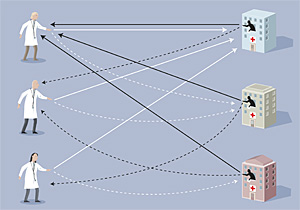The Royal Swedish Academy of Sciences has decided to award the Sveriges Riksbank Prize in Economic Sciences in Memory of Alfred Nobel for 2012 to Alvin E. Roth, Harvard University, Cambridge, MA, USA, and Harvard Business School, Boston, MA, USA, and Lloyd S. Shapley, University of California, Los Angeles, CA, USA
“for the theory of stable allocations and the practice of market design”
Stable allocations – from theory to pratice
This year’s Prize concerns a central economic problem: how to match different agents as well as possible. For example, students have to be matched with schools, and donors of human organs with patients in need of a transplant. How can such matching be accomplished as efficiently as possible? What methods are beneficial to what groups? The prize rewards two scholars who have answered these questions on a journey from abstract theory on stable allocations to practical design of market institutions.

Lloyd Shapley used so-called cooperative game theory to study and compare different matching methods. A key issue is to ensure that a matching is stable in the sense that two agents cannot be found who would prefer each other over their current counterparts. Shapley and his colleagues derived specific methods – in particular, the so-called Gale-Shapley algorithm – that always ensure a stable matching. These methods also limit agents’ motives for manipulating the matching process. Shapley was able to show how the specific design of a method may systematically benefit one or the other side of the market.
Alvin Roth recognized that Shapley’s theoretical results could clarify the functioning of important markets in practice. In a series of empirical studies, Roth and his colleagues demonstrated that stability is the key to understanding the success of particular market institutions. Roth was later able to substantiate this conclusion in systematic laboratory experiments. He also helped redesign existing institutions for matching new doctors with hospitals, students with schools, and organ donors with patients. These reforms are all based on the Gale-Shapley algorithm, along with modifications that take into account specific circumstances and ethical restrictions, such as the preclusion of side payments.
Even though these two researchers worked independently of one another, the combination of Shapley’s basic theory and Roth’s empirical investigations, experiments and practical design has generated a flourishing field of research and improved the performance of many markets. This year’s prize is awarded for an outstanding example of economic engineering.
Alvin E. Roth, U.S. citizen. Born 1951 in USA. Ph.D. 1974 from Stanford University, Stanford, CA, USA. George Gund Professor of Economics and Business Administration at Harvard University, Cambridge, MA, USA, and Harvard Business School, Boston, MA, USA.
Lloyd S. Shapley, U.S. citizen. Born 1923 in Cambridge, MA, USA. Ph.D. 1953 from Princeton University, Princeton, NJ, USA. Professor Emeritus at University of California, Los Angeles, CA, USA.
Prize amount: SEK 8 million, to be shared equally between the Laureates.
The Royal Swedish Academy of Sciences, founded in 1739, is an independent organization whose overall objective is to promote the sciences and strengthen their influence in society. The Academy takes special responsibility for the natural sciences and mathematics, but endeavours to promote the exchange of ideas between various disciplines.
Document
More information
The Laureates
Alvin E. Roth, Harvard University
Lloyd S. Shapley, University of California, Los Angeles
Blog
Market Design
Lectures (video)
Roth, A. E. (2007) What Have We Learned from Market Design, Rosenthal Memorial Lecture. Boston University
Roth, A. E. (2007) Market Failure and Market Design, Google Tech Talks
The Nobel Lectures (8 December 2012)
Review article
Roth A. E. (2008) What have we learned from market design?, Economic Journal, 118: 285–310.
Books
Moulin H. (1995) Cooperative Microeconomics, Princeton University Press.
Roth A. E. och Sotomayor M. (1990) Two-sided Matching: a Study in Game-theoretic Modeling and Analysis, Econometric Society Monograph Series, Cambridge University Press.
Scientific articles
Gale, D. and L. S. Shapley (1962) College admissions and the stability of marriage, American Mathematical Monthly, 69: 9–15.
Serrano, R. (2009) Cooperative games: core and Shapley value, In: Encyclopedia of Complexity and Systems Science, Edited by R. Meyers. New York: Springer.